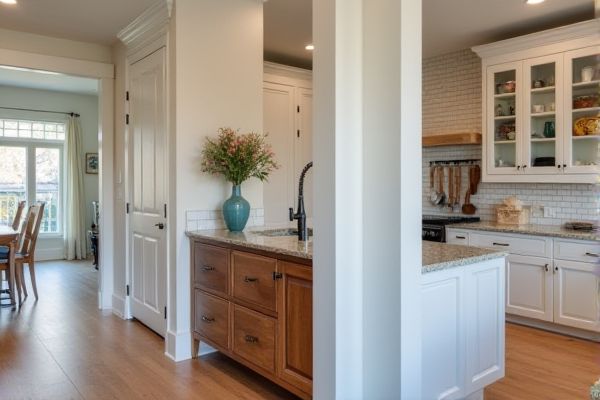
Open pantries offer easy access and visibility for your kitchen essentials, creating an airy and organized feel, while closed pantries provide concealed storage that helps maintain a tidy appearance and protects items from dust. Explore the rest of the article to discover which pantry style best suits your kitchen needs and lifestyle.
Table of Comparison
| Feature | Open Pantry | Closed Pantry |
|---|---|---|
| Visibility | Items are visible and accessible | Items hidden behind doors or walls |
| Space | Optimizes kitchen space visually | Dedicated enclosed storage space |
| Organization | Requires regular tidying to maintain order | Easier to conceal clutter, better for long-term storage |
| Design style | Modern, minimalist, or rustic looks | Traditional, contemporary, or custom cabinetry |
| Cost | Usually lower cost, simpler installation | Typically higher cost due to doors and built-ins |
| Maintenance | Requires frequent cleaning of visible shelves | Less frequent cleaning, protected from dust |
| Security | Limited, open access for all users | Locked or restricted access possible |
Introduction to Pantry Types: Open vs Closed
Open pantries offer easily accessible storage with visible shelves, ideal for quick retrieval and creating an airy, decorative kitchen vibe. Closed pantries provide concealed storage, protecting food from light and dust while maintaining a clean, uncluttered kitchen appearance. Your choice between open vs closed pantry impacts kitchen organization, aesthetics, and maintenance requirements.
Key Differences Between Open and Closed Pantries
Open pantries offer easy access and visibility, promoting quick meal preparation and convenient organization of frequently used items. Closed pantries provide enhanced protection from dust, pests, and light exposure, preserving food freshness and enabling a tidier appearance with concealed storage. Storage capacity varies, as closed pantries often include adjustable shelves and doors that maximize space efficiency, while open pantries prioritize accessibility.
Design and Aesthetic Considerations
Open pantries create an airy, modern look by showcasing your organized kitchen essentials, enhancing the visual appeal with easy access and decorative displays. Closed pantries offer a sleek, minimalist aesthetic by concealing clutter behind doors, maintaining a clean and streamlined kitchen design. Your choice depends on balancing visible storage as a design feature versus hiding items for a more polished, controlled appearance.
Space Efficiency and Storage Solutions
Open pantries maximize space efficiency by utilizing vertical shelving and easy access to frequently used items, allowing you to quickly locate and grab essentials. Closed pantries offer concealed storage that minimizes visual clutter and can incorporate customizable shelving, baskets, and doors to optimize organization. Both options provide versatile storage solutions tailored to your kitchen layout and usage preferences.
Accessibility and Convenience Factors
Open pantries offer easy accessibility by allowing you to quickly see and reach ingredients, making meal preparation faster and more efficient. Closed pantries protect food from dust and pests, providing a cleaner storage environment but requiring you to open doors or cabinets to access items, which can slow down the cooking process. The choice between open and closed pantry designs impacts convenience depending on your kitchen layout and how frequently you need to access stored goods.
Organization and Clutter Management
Open pantries enhance organization by providing easy visibility and quick access to items, promoting consistent tidiness and reducing clutter accumulation. Closed pantries conceal stored goods, helping to maintain a clean kitchen appearance but often requiring more effort to keep orderly and avoid hidden clutter. Effective organization tools such as clear containers and labeled bins are essential in both pantry types to maximize space and minimize disorder.
Hygiene and Food Safety Concerns
Open pantries expose food to airborne contaminants, dust, and pests, increasing the risk of foodborne illnesses and reducing overall hygiene. Closed pantries provide a sealed environment that helps maintain optimal temperature and humidity levels, preventing spoilage and cross-contamination. Properly designed closed pantries allow for better organization and ease of cleaning, thereby enhancing food safety standards.
Cost and Installation Comparison
Open pantries generally incur lower costs due to minimal materials and simpler installation processes, often requiring only shelving and basic supports. Closed pantries involve higher expenses from cabinetry, doors, and hardware, with more complex installation including precise measurements and finishing work. The choice between open and closed pantries impacts overall budget and time investment, with open designs being more cost-effective and quicker to install.
Best Uses and Suitability for Your Kitchen
Open pantries excel in kitchens with limited space, offering quick access and visibility for frequently used items, ideal for small apartments or modern minimalist designs. Closed pantries provide superior protection from dust and pests, perfect for larger kitchens that require organized storage for bulk goods and infrequently accessed items. Selecting between open and closed pantries depends on your kitchen's layout, storage needs, and aesthetic preferences to optimize functionality and convenience.
Final Verdict: Choosing the Right Pantry Style
Open pantries offer easy access and better visibility of contents, making them ideal for frequent use and aesthetic display. Closed pantries provide enhanced organization, protection from dust, and a neater appearance, suitable for families prioritizing cleanliness and storage control. The final verdict depends on individual lifestyle preferences, kitchen layout, and maintenance willingness, balancing accessibility versus tidiness.
 homyna.com
homyna.com